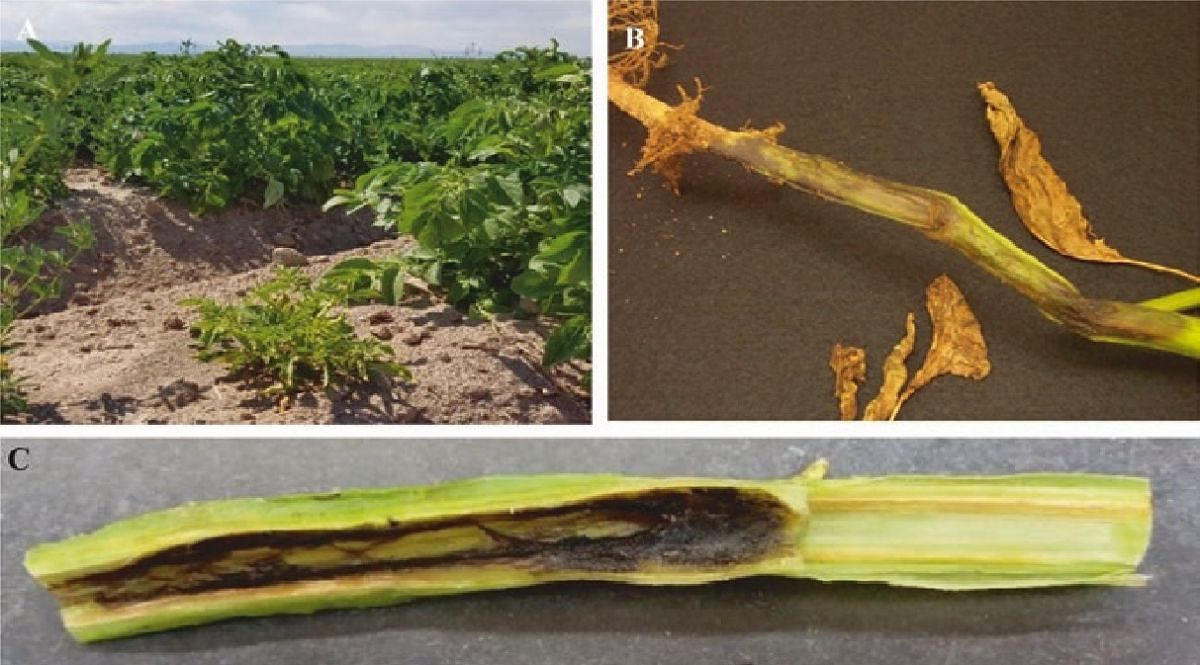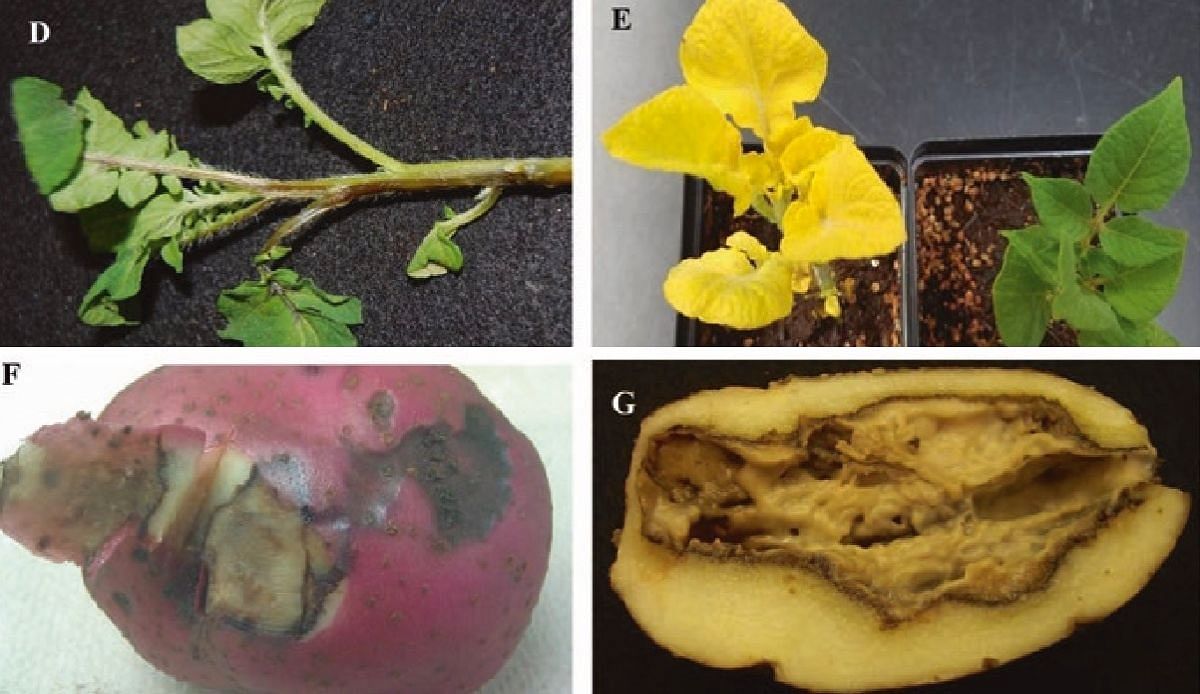Scientific description of Bacterial Blackleg and Tuber Soft Rot Symptoms Caused by Pectobacterium (2020)
Based on Charkowski A., Sharma K., Parker M.L., Secor G.A., Elphinstone J. (2020) Bacterial Diseases of Potato. In: Campos H., Ortiz O. (eds) The Potato Crop. Springer, Cham
The authors of this content are Amy Charkowski, Kalpana Sharma, Monica L. Parker, Gary A. Secor, John Elphinstone
Bacterial Blackleg and Tuber Soft Rot Symptoms Caused by Pectobacterium
Taxonomy and Nomenclature
The genera Pectobacterium is a member of the ß-Proteobacteria in the family Pectobacteriaceae within the order Enterobacterales. The Pectobacteriaceae family also contains the genera Brenneria, Dickeya, Lonsdalea, and Sodalis (Adeolu et al. 2016).
Pectobacterium originally belonged to the genus Erwinia (Winslow et al. 1917) with the name Pectobacterium being proposed by Waldee (1942). However, the name Erwinia persisted until Hauben et al. (1998), using 16S rDNA analysis, re-proposed the name Pectobacterium, which has been used since.
There are currently 12 species of Pectobacterium including P. aroidearum, P. atrosepticum, P. betavasculorum, P. brasiliense, P. cacticida, P. carotovorum, P. odoriferum, P. parmentieri, P. peruviense, P. polaris, P. punjabense, and P. wasabiae (Dees et al. 2017a, b; Khayi et al. 2016; Nabhan et al. 2013; Sarfraz et al. 2018; Waleron et al. 2018; Zhang et al. 2016a, b).
Host Range
Pectobacterium species have a wide range of host plants with approximately a third of these overlapping with hosts for Dickeya species (Charkowski 2018; Ma et al. 2007a, b). For Pectobacterium species, hosts have been identified in at least 20 dicot families in 13 orders and 12 monocot families in 6 orders, often with only a single isolate being associated with a particular family or order.
This may be due to lack of reporting rather than a clear difference in the abilities of these two genera to infect (Charkowski 2018; Ma et al. 2007a, b). However, some important specialization may exist since Pectobacterium appears to be found more frequently than Dickeya on cabbage, cotton, and mango, and Dickeya but not Pectobacterium on rice and maize.
Some species such as P. atrosepticum, P. betavascularum, and P. parmentieri appear to have a very narrow host range, and P. aroidearum appears to be more virulent on monocots than other Pectobacterium species (Nabhan et al. 2013).
The Pectobacterium species most commonly found on potato include P. atrosepticum, P. brasiliense, P. carotovorum, P. odoriferum, P. parmentieri, P. peruviense, P. polaris, and P. punjabense.
Geographical Distribution
Pectobacterium species are found on all continents where potato is grown, and are likely to be present as saprophytes in the soil, water, and are also regular inhabitants of plant roots when not causing disease. While there are likely to be some regional differences in the species distribution, some appear to be ubiquitous.
For example, P. atrosepticum, P. brasiliense, P. parmentieri, and P. carotovorum are found on multiple continents (De Boer et al. 2012; Duarte et al. 2004; Kim et al. 2009; Ngadze et al. 2012; Pérombelon and Kelman 1987; Pitman et al. 2008, 2010; She et al. 2017; van der Merwe et al. 2010; van der Wolf et al. 2017; Wang et al. 2017a, b, c).
In Europe, P. atrosepticum has been the predominant species responsible for blackleg disease on potato, with P. carotovorum responsible a minority of blackleg disease incidents but often associated with soft rot in storage.
Recently, at least some of these P. carotovorum strains were been reclassified as P. wasabiae and subsequently as P. parmentieri (Khayi et al. 2016; Nykyri et al. 2012). P. brasiliense, which was originally identified as causing disease on potato in Brazil (Duarte et al. 2004), has been common in the United States since at least 2001, as has P. parmentieri (Kim et al. 2009; Yap et al. 2004).
P. brasiliense was not known to cause disease on potato in Europe prior to 2012–2013 but has since increased greatly in its incidence in many European countries (de Werra et al. 2015) and is now recognized as an important pathogen in Africa as well (van der Merwe et al. 2010).
Symptoms
Pectobacterium causes blackleg, which is a stem necrosis that originates from the planted seed tuber (Pérombelon 2002) (images below). Necrotic symptoms often extend several centimeters up the stem and necrotic vascular tissue is typically present inside the stem several centimeters beyond where general stem necrosis occurs.
The pith of the stem is often decayed. Plant leaves may turn bright yellow and the plant will eventually wilt and die. Infected plants produce few or no tubers. Pectobacterium can enter daughter tubers through the xylem or through wounds caused by insects, frost damage, or harvest equipment.
Once inside a tuber, it will decay the inside of the tuber, but not the tuber periderm, causing bacterial soft rot. The bacteria will also decay stems damaged by cultivation equipment or severe weather, causing aerial stem rot. In all cases, it is common to find multiple Pectobacterium species or Pectobacterium and Dickeya together when blackleg, aerial stem rot, or soft rot symptoms are present (Kim et al. 2009; Yap et al. 2004).
In the United States, P. partmentieri is often found with other decay pathogens, such as Clavibacter michiganensis and potato rot nematode.

Bacterial blackleg and tuber soft rot symptoms caused by Pectobacterium on potato. (a) Plants with blackleg are shorter and have curled leaves (A), the stem is blackened on the outside (b), the pith inside is decayed and the xylem are brown (c).(Courtesy: Amy O. Charkowski, Colorado State University)

Brown or black decay may spread into leaves (d) or leaves may turn bright yellow (e). Tubers may have swollen lenticels and sunken lesions (f). The soft rot bacteria may enter the tuber through the stolen and decay the center of the tuber (g) (Courtesy: Amy O. Charkowski, Colorado State University)
Epidemiology
The most common Pectobacterium strains in a region change from year to year and the strains and species present are also not consistent across a particular continent (Dees et al. 2017a, b). The species also differ in optimal and upper limits of growth temperatures.
For example, P. atrosepticum and P. parmentieri die above 33 °C, but P. carotovorum and P. brasiliense can grow at temperatures up to 39 °C.
Initial seed potato production relies on pathogen-free micropropagated plantlets. These plantlets are grown in greenhouses or screen houses to produce minitubers, which are used for field planting.
Pectobacterium is sometimes found in or on minitubers, but it is more common on potato ones the tubers have been grown in the field. Each generation of potato multiplication tends to increase Pectobacterium incidence on potato tubers.
Since Pectobacterium is common in the environment and can be found in soil, water, weeds, and insects, it is not feasible to produce potatoes free of this pathogen (Charkowski 2015).
The bacteria may also be spread by insects (Kloepper and Schroth 1981), but the importance of insects compared to other routes of spread remains unknown.
Pectobacterium appears to spread mainly at harvest. Bacterial numbers increase dramatically on senescing vines and the bacteria will contaminate harvest equipment and may become aerosolized during harvest. In tubers, the bacteria are found in lenticels and inside the stolon scare.
Asymptomatic infestations are common, so it is not possible to visually assess seed potato lots for risk. Blackleg development is highly dependent on the environment and it is unpredictable, even when a seed lot is known to be contaminated with Pectobacterium. Detection protocols useful for studying Pectobacterium epidemiology were recently complied (Humphris et al. 2015).
Pathogenicity Determinants and Resistance
Pectobacterium pathogenicity depends upon secreted plant cell wall-degrading enzymes, although several other factors also contribute to virulence (Charkowski et al. 2012). The genetic basis for the observed host range limitation in some Pectobacterium species and differences in ability to grow at temperatures above 33 °C remain unknown.
There are no examples of gene-for-gene resistance with this necrotrophic pathogen. The antimicrobial peptide Snakin-1 enhances resistance when overexpressed in potato 329–338 and some wild potato species exhibit resistance to Pectobacterium (Rietman et al. 2014), but the basis for resistance in wild potato species is poorly understood.
There are no resistant commercial potato varieties, but varieties differ in tolerance. There is a large environmental component to disease development for blackleg and little effort has been made to correlate laboratory assays for tolerance with results observed on grower farms.
The recent identification of numerous new Pectobacterium species suggests that additional novel and potentially high virulent species remain to be discovered and also that this high level of diversity will hinder development of tolerant potato varieties.
Significance and Economic Loss
Pectobacterium has served as a model pathogen for phytobacteriology research for longer than almost any other bacterial pathogen, except Erwinia amylovora, and Pectobacterium research has resulted in some notable firsts, such as the first demonstration of the role of quorum sensing in bacterial pathogenicity (Pirhonen et al. 1993).
It remains an economically significant disease worldwide. Farmers lose millions annually to blackleg, aerial stem rot, and tuber soft rot. Of these, tuber soft rot can be particularly devastating since it occurs after the farmer has invested a full season of inputs into growing the crop.
Management
Pectobacterium management relies mainly on cultural practices (Charkowski 2015; Czajkowski et al. 2011). Growers initiate potato production with micropropagated plantlets that are free of Pectobacterium, but tubers are quickly contaminated once they are planted in fields.
To reduce the risk of disease at planting, growers should fully suberize seed if they are using cut seed and they should not plant cold seed into wet ground.
During the growing season, they should irrigate with ground water if possible and not overfertilize with nitrogen. Rouging infected plants is likely to spread the disease, so this is not recommended.
At harvest, the bacteria will multiply on the vines as they senesce, so quickly killing potato vines may aid in reducing disease incidence the following year. Tubers should be allowed to heal before cooling storages.
Good airflow and high humidity in potato warehouses will also aid in reducing soft rot in storage. High levels of carbon dioxide in warehouses will promote soft rot development.
